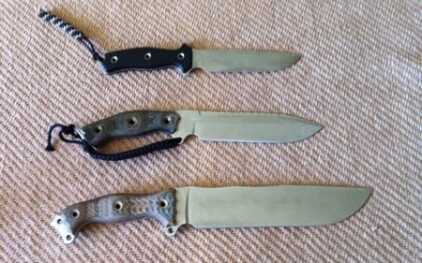
My combat knives. From top to bottom: Swamp Rat RMDeux LE, Nuclear Steel Heart Ergo, Fusion Battle Mistress LE. If you know anything about Busse Combat knives, you know that those aren’t cheap.
I know what you’re going to say. This is GunsAmerica. Not KnivesAmerica. But we’ve been kicking around a big question lately. That question is hard to frame, but it goes something like this, are expensive guns worth what you pay for them? Or you could ask it’s transverse, why would anyone pay big money for a gun when cheap guns work just as well? Clearly the target you are shooting doesn’t care if your chunk of lead comes out of a Guncafter 1911 or HiPoint. And the same questions apply for optics and a lot of gear. The simple fact is that modern machining is leveling the playing field.
So what’s the answer? I guess it depends on what you’re talking about. And today, I’m talking about a knife. This is a topic we’ve explored before from another angle, specifically “Cheap Damascus Knives For Christmas.” But I’m looking at a knife that’s a bit more refined.
See, I had an epiphany over the summer. As mentioned, it had to do with my love of knives. I realized that as much as I enjoy collecting tactical and combat knives, I rarely used them. Living in and around city centers for the past decade (Los Angeles, Buffalo, Louisville) I almost never got an opportunity to take them out and put them through their paces, sadly. Aside from the occasional excursion to the countryside to visit friends or the infrequent trip to a wooded hiking trail on a weekend afternoon, my beloved knives sat in a dresser drawer and collected dust.
I was beginning to think I had wasted money. Some of my combat knifes are worth serious cashola. Due to that eye-popping price tag and the proprietary steel they’re made from, they are meant to be used and abused! And that’s exactly what I wanted to do. I wanted to pack up some camping gear, grab my knives and head into the wild to chop down some dead trees, build a cool fort, baton some fire wood, whittle some sticks, make a spear — you know, all the fun things that the kid-in-us wants to do with knives. I just never seemed to find the time.
Continuing with that aha moment, I then recognized that although I didn’t use my combat knives all that often I did use one knife almost everyday. It was a $20 Oneida chef’s knife I bought at a Burlington Coat Factory some years back when I first started learning how to cook.
I then asked myself, Why am I spending top dollar on combat knives I hardly use and virtually nothing on a tool that I handle on a daily basis? The next question was rather obvious, do I really need to spend more money on a kitchen knife or is my $20 Oneida perfectly suited for the tasks at hand?
Quite honestly, I never had a major issue with my $20 Oneida. As a one-sized-kinda-fits all knife with a lifetime warranty, it performed well on pretty much everything I threw at it — I should note that I’m a novice cook and not a chef. I don’t do any advanced trickery in the kitchen. Just basic slicing, dicing, chopping, carving, etc. — The truth was I didn’t need a new chef’s knife. But after that inspiring cognition, I decided I would get one anyhow.
When it comes to certain items I like to have the best of the best. I guess I’m a gear snob to some extent. I like to have stuff that (a) is top of the line (b) no one else has (c) is aesthetically pleasing. Let’s be honest, it’s fun to show up with something that makes a friend covetously inquire, “Where did you get that?!”
So, I did some research into knife makers and kitchen cutlery. I came across a knife maker by the name of Ban Tang. He makes all sorts of cool knives, from large bowies to competitive choppers to a variety of awesome-looking EDC knives. And, of course, kitchen knives. The name of his operation is Ban Tang’s Stupid Sharp Knives. As the name suggests, his blades come with a razor’s edge.
After looking over his catalogue, I ordered two knives. A paring knife and a santoku. I’m going to feature the santoku knife in this article, even though the titanium paring knife he made me is badass. If you’re not familiar with the santoku, it’s Japan’s version of the chef’s knife. It’s an all-purpose cutlery instrument with a sheepsfoot blade that is carefully balanced and aptly suited for slicing, dicing and mincing. To the layperson (which I am admittedly — I am not an expert or a seasoned knife reviewer), when compared to the chef’s knife the tip is less pointy and the vertical width of the blade is thicker.
The santoku knife Ban made me had the following dimensions:
- 10 1/2″ OAL with a 6 3/4″ Blade
- .100 thick AEB-L Steel
- Full Convex Grind
- High Polished Convex Edge
- Black Diamond Wood Handles
As you can see in the photos, the blade is sweet! The obvious question now is, what did I pay for it? Unbeknownst to my GF, I dropped $300 for it. To move on to the next obvious question: Was it worth it?
Yes, absolutely. The knife is great. Like my $20 Oneida it comes with a lifetime warranty. I can also send it in to Ban at anytime for re-sharpening. With respect to performance, the knife eats anything in its path. It sings when it slices, dices and minces fruits, vegetables, poultry, beef; basically whatever I’m cutting in my kitchen. And it’s sharp as hell. To state the obvious, it’s “stupid” sharp. Why is it so sharp? Well, it’s made from AEB-L steel, a popular stain resistant steel that is known to take a very fine edge due to its fine grain structure. It’s why it’s known as “Swedish stainless razor steel,” because many knife makers use it for razors.
Ban heat treats his AEB-L using a paragon furnace. After the furnace it is tempered once before undergoing cryogenic treatment. Then it is tempered two more times to reach 61 HRC. With respect to the scales or handles, they are attached via epoxy plus stainless rivets. The rivets are basically fairly thick walled tubing that are flared out under high pressure using a special die.

AEB-L properties and rating chart. AEB-L is made up of Carbon: .67%, Chromium: 13.00%, Manganese: .60%, Phosphorus: .025%, Sulfur: .015%, Silicon: .40% (Chart: ZKnives.com)
Does it outperform every other kitchen knife I’ve ever owned, including the $20 Oneida? My inclination is a resounding yes but I can’t say that for sure as I have not done any empirical side-by-side testing — nor do I plan on doing any (I personally believe that hand testing one knife versus another is an ultimately flawed and reductive process unless it’s done by a professional. Too many variables to reach any reliable results. Are the blades equally sharp to begin with? Am I applying the same pressure when I use one versus the other? Am I cutting at the same angle? Obviously, this is a totally different discussion for a totally different article.)
What I can say for sure, however, is that with my santoku a mundane culinary task like chopping the potatoes or mincing the garlic becomes a pleasurable and engaging experience. I actually look forward to kitchen prep now. That to me is worth the price tag alone.
Yet, I recognize that by not doing a real comparison comparison test, either with my Oneida or another santoku, I am unable to definitively make a case that this knife is superior to others. I can argue that it’s prettier than other knives, but that is inherently subjective. Plus, beauty is in the eye of the beholder. On some level, my affinity for the knife is predicated on the price I paid for it. I place a high value on it because I paid a lot for it. As humans we tend to do this. Hell, as gun owners, we tend to do this. To circle back to those questions raised at the outset of the article, is an Ed Brown 1911 really all that functionally superior to a Springfield 1911 or Rock Island 1911? Ultimately, I think the answer is, it depends on whom you ask.
I love my santoku. But skeptics will wonder, though, are there any drawbacks or shortcoming to the knife? At that price point, perhaps one can argue there shouldn’t be. But after extensive use I’ve noticed a few. I should preface this by saying, I’m being extremely nit-picky here and fussy. Generally speaking, the knife is perfect. I’m only mentioning these because, well, nothing’s perfect.
For starters, I f-ed up when I ordered. I had a choice between Micarta handles and wooden ones. Instead of getting Micarta handles, I went with the diamond wood. It looked cooler, I thought. Yet, now I realize that I should have opted to go with toughness over coolness. Micarta is much more durable than wood. I found this out after my GF accidentally put my titanium paring knife in the dishwasher. She warped the handle. I fear that one day she may inadvertently do the same with my santoku despite my explicit warnings and reminders. In the end, I’ll probably end up having both knives re-handled at some point for this very reason.
Secondly, to put it succinctly, big hands small handle. I have rather large hands. Ogre hands, really. The handle on the santoku is fit for someone with more medium sized hands. Is this really that problematic? No, not at all. But what this means is that during extensive use — say, chili day, when we’re in the kitchen cooking all day — the knife isn’t as comfortable in my hand as it could be were the handle to be bigger. Again, maybe when I get the handle switched out I’ll ask for a thicker one. Then again, proportionally speaking, a thicker handle might blight the sleek design of the knife.
Lastly, this has nothing to do with the knife itself, but instead has to to do with the time it takes for Ban to make you what you want. Four to six months or thereabouts is what I waited to get my knives. As an impatient person that long wait sucked! But Ban’s not shy about telling you that up front. And truth be told, it makes sense. He is a one-man operation, and his cutlery is in high demand. I should have been more prepared to wait.
With all that said, I suggest that you give some serious thought about investing in a quality kitchen knife. Whether it’s a high-end chef’s knife or santoku or maybe even a full set of kitchen knives, getting a quality tool(s) to work with has the potential to change your attitude about food preparation and cooking, especially if you’re a knife guy who finds yourself in the kitchen more often than not. I’m sure you don’t have to spend $300 and wait half a year to obtain an optimal knife, but if you’re willing to, you may want to check out Ban Tang. I think you may like what you see.
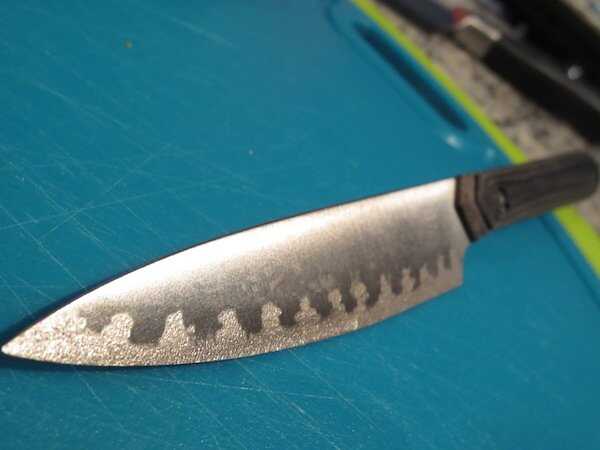
A look at the edge on the titanium paring knife. You’ll note the carbide edge, which acts as a support system for the softer substrate Titanium, and though continued use exposes new carbides on the edge. From what I’ve read on Bladeforums, it “works like a beaver tooth. Beaver teeth have a hard enamel front and soft back. As the chew the back wears away faster than the front keeping a razor sharp edge on the cutting portion.”

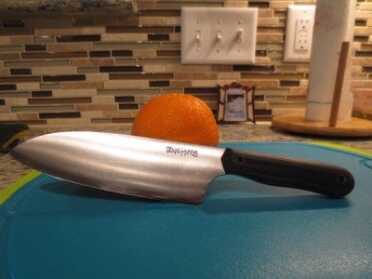

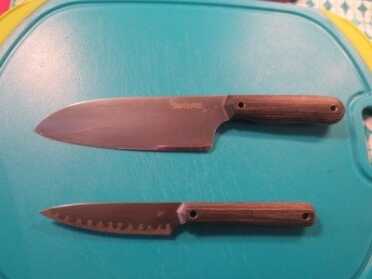
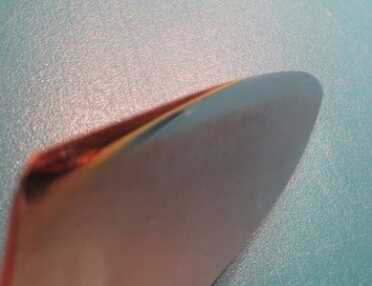
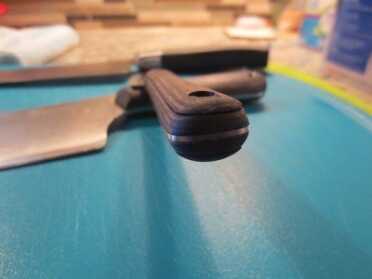
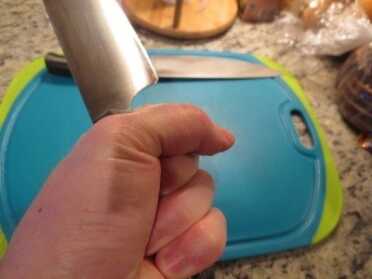

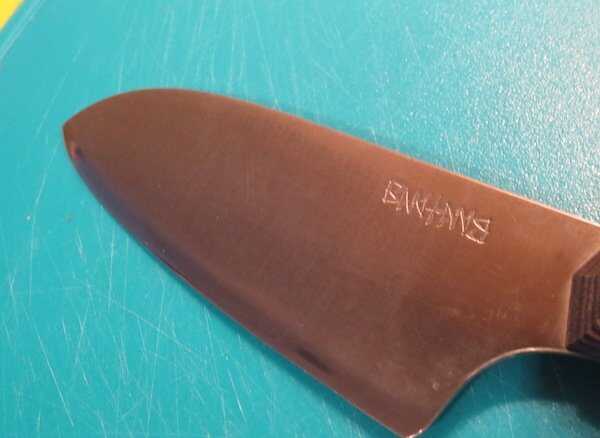
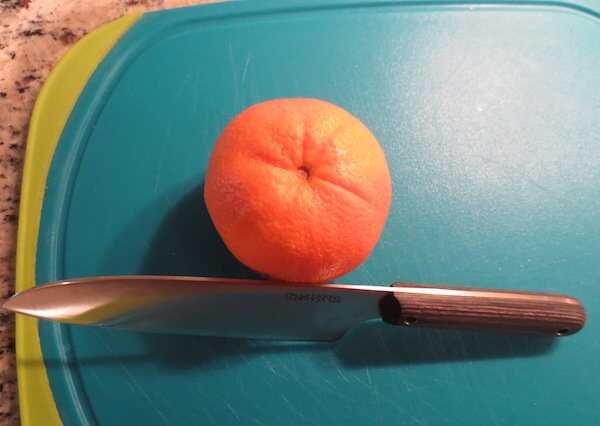
Thanks. I appreciate the time you put in to write this article.
One thing though regarding the handle size. You are holding the knife wrong. That’s why the handle is too small. The proper way to hold a knife is to “choke up” and grip the blade between your thumb and forefinger. If you grip the knife this way, the handle will be plenty big.
Here is a link to a photo.
Don
http://www.seriouseats.com/images/20100527-KS-How%20to%20hold%20a%20knife%20-%203.jpg
I know the information involved Rotor rotor blades and the most effective appear afterwards from Japan with no they aren\’t cheap. I must create a discuss hunting knives. It\’s difficult to locate top quality hunting knives nowadays since several have dull cheap satin rotor rotor rotor blades and junk handles. You can\’t find hunting knives with exotic wood handles and polished rotor rotor rotor blades anymore. Gerber acquainted with have very collectable knives. Today they have produced only pure junk plus they don\’t have anything I\’d even consider purchasing.
I was a personal friend and customer of the late knife maker Jimmy Lile that made the Rambo knife ….and his widow. I overheard someone mentioning the ” you don’t want to take a knife to a gun fight ” to Mrs. Lile at the Tulsa Gun show years ago. She agreed , but said ” Try and peel a potato with a gun ” !!! Makes sense.
Hmmm, maybe I and virtually everyone I know are atypical, but we each already have enough good knives to supply the neighborhood.
You’re not atypical. My knife collection is out of control. I could arm a Central American revolution.
I have ALWAYS been a fan of edged weapons. The most quietest weapon you can own. I have over 200 knives because I know I will have to arm most of my family.
I like my steak knife best because it means i’m eatin steak tonight…
Great article ! Why not Knives America.
Nice article. As a foodie, and knife freak let me suggest that to offset any fatigue from holding the knife for extended periods slide your hand up the blade so that your middle finger rests aginst the back of the blade. That way you can pinch the blade ahead of the handle for better control with your thumb and index finger. Takes some practice but really works.
Zeke D.
Steve G. +1 on the Shun advice
Wow! You certainly provided a forum for an underappreciated topic. I was a pro chef (partial to Sabatier knives) and now find delight in using a 3″ clip blade Oxo paring knife in the kitchen. The handle is perfect, grippy, fills the hand and provides excellent control. I often think why can’t a “tactical” manufacturer make a handle like this? And, re your hand too big for the handle, I sure hope you are holding the chef’s knives with a pinch grip, thumb and forefinger on the blade itself, with the others around the handle. That gives you precise control; it’s the way every professional chef holds a knife.
I have been a “knife-nut” my entire thinking life. I learned from my dad. I have carried all kinds of knives over the course of my life, both on the job and off. I am retired now for quite some time, and I still have at least two knives, of some sort, on me at most times. When I get dressed for my day, I have at least a .380 and a couple knives on my person. I have all types of knives as I am sort of a collector, but my constant carry has been a Benchmade auto for many years. It has never failed me. I also usually carry a Leatherman, usually a micro. I also buy good quality kitchen knives when I find them, and I agree with the author about their utility, in and out of the kitchen. Wusthoff, Henckel’s, Case, Russell, and Al Mar are a few of the brands in our kitchen. I care for them as I do all of my tools by wiping them down, oiling them as needed, and NOT putting them in the dishwasher or leaving them in a drying rack to rust (yes, even stainless rusts). When I buy a kitchen knife, I look at it’s design and materials for their utility both in and out of the kitchen. One never knows when a nice big chef’s knife may be the most convenient weapon at hand during a home invasion/robbery. I have found many treasures at flea markets, yard/garage sales, and gun shows. As far as I am concerned, a gun and knife go together like salt and pepper. I would not leave my house without either. That’s just being smart, in my book. Good article!
I realize that the article was about Kitchen knives and the very best seem to come from Japan and no they are not cheap. I would like to make a comment on hunting knives. It is very hard to find good quality hunting knives these days as most have dull cheap satin blades and junk handles. You cannot find hunting knives with exotic wood handles and high polished blades anymore. Gerber used to make some very collectable knives. Today they make nothing but pure junk and they do not have anything I would even consider buying.
Sometimes if you want quality, you have to do it yourself.
Here’s a great Knife source. (Many ideas to ponder)
http://www.knifekits.com/vcom/index.php
Pay special attention to; Handle Materials.
There are incredibly exotic and modern / durable materials you might replace your present blades with.
Enjoy.
You need three knives and at least one pocket knife (I carry 2 plus an extra one when I’m hunting), 1 to cut wood, 1 for everyday and defensive use and, 1 to do fine work and a good job skinning. In ‘Nam I carried a French Sangalese (sp?) Bolo for wood, vine cutting, chopping, and self defense (it was rather straight, and had about a 45* angle at the end, was about 18-20 inches of blade, plus about 10 inches of a good secured hard wood tang with rivets). I had my trusty KA BAR for the every-day things (and kept it VERY sharp) and self defense, and an old Browning that they don’t make anymore, it was VERY much like their “Feather weight big game” knife. It differs from the one they sell today because it had not only the straight blade, gut hook, and saw, but also a fourth blade which was a blunt curved ‘skinning’ blade that would fit up under the skin and the membrane below it and just peal the hide off without poking holes in it. I gave that to a sweetheart once, to my regret, loaned out the Bolo to a FWD buddy who was going up an rather unused road, and still have my KA BAR that I can use for anything from a hammer, small wood splitter, and of course, self-defense. And now I carry a Leatherman and a Swiss Army with the scissors, pliers, and saw (plus ball point pen etc) everyday since there’s always something that needs to be fixed right.
Every truck I have has it’s own minimal ‘skinning’ kit in it that has from 3-5 knives depending on the brand – that’s just common sense. Like a come-along and a high-lift jack.
Anyone who’s been to ‘Nam knows how GREAT their knives are – and I found that when I was part owner (the cook) of a restaurant I PREFERRED my $3.50 Japanese knife to my $300 custom Wustoff. First off it sharpened up in about 1-2 minutes by hand, the Wustoff took a good $100 and the time to take out and put away a high end rotary knife sharpener and about 5-6 minutes to put a good edge back on it. Plus it was almost too heavy.
Any blade that will ‘hold it’s edge forever’ is made out of steel so strong that you’ll likely NEVER be able to sharpen it. That’s why I like my small Usuba Bocho for veggies and meat, and my small 9 inch Sashimi Bocho for fish or a ‘boning’ knife. though they cost pennies on the dollar compared to the Wustoff or Henckels 5 Star — but do about the same thing, but the Bocho’s are about $40 total, not $200+ each. AND they take an edge really rapidly – unlike the German knives which will last most of a week without sharpening, the Bocho’s need at least a leather a couple of times a day, if not about a minute or less on a stone, they take a razor edge, and hold it for hours of serious cooking. Now that I’m not around kitchens, having sold out and moved on, I find I reach for my French Chefs knife maybe twice a month, but use my Bocho’s every day. (For a good selection of Eastern knives for cooking and every-day use try The Wok Shop – they have an amazing assortment to choose from. AND they ship FAST – call them and they’ll tell you more than you need to know about the differences between knives – and though two knives may look alike, they are NOT all the same – some, for example, are sharpened only on one side.).
But next to those – the old Browning pocket knife with the skinning blade was one of the best hunting knives I’ve ever used. And in Combat (though I was never called upon to pull a knife) it would be the Bolo and then the KA BAR – bolo first because it had about an 18 inch solid blade which if it made contact would do a world of hurt, and the KA BAR puts me a tad too close where I don’t really care to be. The Bolo would (does) cut through a bear femur in one whack if you want some gauge of strength.
Thanks for the Wok Shop tip Doc, lots of good inexpensive stuff there.
I especially like the blocks, and since I use a chef knife for practically all kitchen jobs, that “Deba bocho” is looking good.
Sounds like your good to go with that KA BAR
If it came down to 1 blade, that would be it.
If you liked that Bolo blade of yours, you might want to look into the Khukuri.
I listed the one’s I own above (5 comments up). Check out the “Eli”, It can be used like your Bolo, but can be utilized for other survival tasks, and has a bolted handle, enable ing it to be affixed to other handles or staffs.
I think the ancient Khukuri design is superior to the Bolo for intended use.
Go to that site where I bought these blades to see the history and complete information on all things Khukuri.
Also learn about the Gurkha Warriors who used them. It’s pretty interesting.
These Gurkha fighters are why our military went to .45 instead of 9 mm. (trivia)
Hey I was just reading your article and I have few thoughts about it. I think that you have some pretty cool kitchen knives. That being said I am a professional chef and I put miles on my own set. I have had numerous high end blades for work and also play I am an avid hunter slash collector. I have had every different type of style kitchen knife and the best knife maker is Shun. ( pronounced shoon ) They last a professional who uses them 50 hours a week or more 5-10 years of abuse. They are perfectly balanced, handmade, light weight, which translates to speed, and they are sharp as a sergeon scalpel. Lifetime warranty which includes free servicing. Another cool thing about these is that the hammered folded steel collects some of the coal or carbon used in the forging process thus createing microscopic teeth in the blade So even when dull they are still easily able glide through anything you need it to. Anyways I am not a salesman for theM but try one and you will buy another Guaranteed. And one one more thing sandoku knives are for noobs. sandoku means all purpose roughly translated But the tip is not pointed I realize it’s still sharp but it’s not all purpose it’s to small to be all purpose aND missing the point. that said you have a very nice one but the only chefs I have seen use sandoku knives are students right out of culinary school, or people new to fine knives. Mostly because I think people think they look cool but they are not so practical. Also the tips on sandoku knives break off even with normal use that is covered by warranty but I know how 8t feels when a 100-200 $ KNIFE tip snaps off it sucks not to mention if you can’t find it you risk eating the broken peice. alright I am blabbing now, cool knives. I just think you payed too much for a knife that has a cheap looking handle that will collect moisture and bacteria ( definitely not nsf cert.) No matter what you do to it. I think that knife is kind of like a coversation peice and I dunno about you but argueing about the best knife maker will be like the old m16/ak47 ,9/40/45 ,ford/Chevy arguments and go nowhere they are all good and it’s cool seeing your collection of razor sharp art.
If you like the touch and appearance of wood, have the handles replaced with mesquite. It is dishwasher safe. Commercial kitchens that use solid mesquite cutting boards run them through their dishwashers for hundreds or thousands of cycles. Mesquite does not warp. Plus, it is 2.5 times harder than red oak so it does not ding either. It is a superior natural product for a knife handle.
All that being said, I would still not put a mesquite product in the dishwasher. Somehow, even if it can tolerate it, I have to believe it just is not optimal. But it is nice to know you are protected if it happens.
Among the knives I have, my two favorites are: A USMC issued KBAR and a USMC issued M4 bayonet for an M1 Carbine. Both have decades of proven use and are easily sharpened with a set of good stones. Both are heavy blades that withstand hard use. Both are parkerized and withstand harsh conditions and both have stacked leather handles that make using them a joy. The KBAR serves when I need a larger blade and the M4 when I need a smaller one. It has the muzzle guard that functions perfectly as a hand guard and is light and well balanced for its size. Blood groves are a plus and the leather sheaths that came with them are quiet, durable and add a little panache. I also have several versions of other bayonets including ones for the M1 Garand, M14 and M16/M4.
None of these are expensive except for the original as issued 16″ Garand bayonet from Springfield Armory if you bought it today. Like most, I have several folding knives and a few hunting blades but for SHTF the KBAR and M4 would be my choices to carry while the M7 bayonet for my AR would be a close second.
I could have said exactly the same thing for the same reasons. You took the proverbial words from my thoughts. For me it is my old KBar (60s) model and an Imperial M5 (53) model for my Garand. They are as tough as any I have ever used. They, like the old Timex commercials, “Takes a licking, and keeps on ticking”. They have been through hell too and still work like new. Otherwise, I carry a Victorinox multi tool, everywhere and use it nearly everyday for one task or another. I still have an old Buck 119 with sheath that is pushing 50 years old now. Still looks like new. The important thing with all of them, their ability to hold a keen edge under extreme use and abuse. To me, that is the benchmark of any knife, along with the strength of the steel under abusive conditions like a SHTF situation.
I’m with you guys.
For fighting, I have my Full size powdered metal 7″ Black stacked leather KA BAR (no picture, can’t find one) stamped US Ontario.
My Khukuris; (they slice and dice) I can cook, fall trees or sacrifice a water buffalo with these!
1.http://www.thekhukurihouse.com/catalog/enlarge.php?id=323931fe4d5&image=left
2. http://www.thekhukurihouse.com/catalog/enlarge.php?id=323937fc2012&image=left
Doesn’t everyone have a multitude of various blades? LOL
WHAT I THOUGHT THIS ARTICLE WOULD BE ABOUT;
My Leatherman Tool; http://www.leatherman.com.au/product/PST
I started to laugh to myself pretty hard when you had mentioned that your GF put your prized wood handle knife in the dishwasher. Of course I only thought it funny because I have experienced the same thing with my wife, mom, buddies girlfriends and my mother in law. I too have had to give explicit warnings on not putting my wood handled knives or other items in the dishwasher as well as not soaking cast iron or turning the heat on cast iron pans or woks up on high. I had a friends GF who was a chef of all things ask “why do you have to make your knives so sharp?” Answer “because a dull knife is a dangerous knife” Thanks for the laugh.